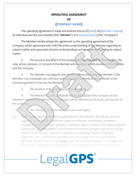How to Structure a Sponsorship Agreement That Attracts Big-Name Sponsors
Securing a big-name sponsor can transform an event, organization, or business. A well-structured sponsorship agreement does more than bring in...
8 min read
LegalGPS : Apr. 11, 2025
Sponsorships can be a game-changer for events, providing critical funding, marketing support, and brand credibility. However, securing sponsors isn’t just about asking for money—it’s about proving that their investment will generate real value.
Many sponsorship deals fall apart because event organizers fail to define measurable outcomes in their agreements. If a sponsor isn’t sure how their success will be tracked, they’re less likely to commit, and even less likely to renew. A sponsorship agreement that includes clear performance metrics, tracking systems, and post-event reporting gives sponsors confidence that their investment is worthwhile.
To structure a sponsorship agreement that guarantees measurable ROI, you must start by understanding what sponsors care about most, defining specific deliverables, and setting up systems to track and report performance. Here’s how to do it effectively.


Legal GPS Pro
Protect your business with our complete legal subscription service, designed by top startup attorneys.
A strong sponsorship agreement starts by aligning with the sponsor’s definition of success. While some brands are looking for brand awareness, others prioritize lead generation, direct sales, or audience engagement. The key to structuring a high-value sponsorship agreement is understanding exactly what results the sponsor expects.
Not all sponsors use the same criteria to determine if a sponsorship was successful. Some common ways sponsors measure ROI include:
Sponsors will only continue investing in your event if their goals align with the opportunities you provide. That’s why it’s important to discuss their specific expectations before drafting the agreement.
Imagine an event with two potential sponsors: a soft drink company and a B2B software firm.
The soft drink company is primarily focused on brand visibility and audience engagement. They want product samples in attendees' hands, branded social media posts, and on-site activations that generate excitement.
The B2B software firm, on the other hand, doesn’t care about broad exposure. Their priority is direct conversations with decision-makers that lead to new business deals. For them, lead generation is more important than logo placement.
A one-size-fits-all sponsorship agreement won’t work in these situations. The sponsorship must be structured to meet the specific goals of each brand, ensuring that they see a clear return on investment.
Before finalizing a sponsorship agreement, have a discussion with the sponsor about what success looks like for them. Some key questions to ask include:
By gathering this information upfront, you can structure an agreement that delivers measurable results tailored to the sponsor’s needs.
Once you understand what the sponsor values, the next step is translating those priorities into measurable deliverables in the agreement. Without clear metrics, sponsors may feel uncertain about whether their investment was successful, leading to missed renewals or disputes.
Many sponsorship agreements fail because they use vague language. A contract that simply states, “Sponsor will receive high visibility and audience engagement” leaves too much room for interpretation. What does “high visibility” mean? Does “engagement” refer to social media interactions, booth visits, or actual purchases?
When expectations aren’t clearly defined, sponsors may walk away feeling underwhelmed or misled, even if the event was a success.
To make ROI trackable, sponsorship agreements should outline specific, quantifiable performance indicators. Some of the most effective metrics include:
A technology company sponsored a major industry expo, expecting to generate high-quality leads. However, the agreement only included logo placement and stage mentions, with no guarantee of booth traffic or attendee engagement.
At the end of the event, the company received almost no direct leads, leading to frustration and disappointment. Had the contract included structured engagement metrics—such as a guaranteed number of demo opportunities or a post-event attendee email list—the sponsor would have seen clear value in their investment.
When defining sponsorship deliverables, spell out exactly what the sponsor will receive and how success will be measured. Instead of vague promises, use specific commitments like:
By clearly defining deliverables, you ensure that both parties have realistic expectations, and sponsors feel confident in their investment.
A sponsorship agreement is only effective if you can prove that the sponsor received measurable value. Many event organizers make the mistake of focusing on deliverables but neglecting how to track their performance. If a sponsor can’t see the impact of their investment, they’re far less likely to renew.
High-profile sponsors expect data-driven insights. They don’t want vague assurances that their brand received visibility—they want to know how many people engaged, what actions they took, and how it translated into business results.
If your sponsorship agreement includes a structured tracking and reporting system, it not only provides transparency but also strengthens your credibility. Sponsors who receive clear data are more confident in increasing their investment in future partnerships.

Boost Your Brand with Sponsorship Now!
Legal GPS templates are drafted by top startup attorneys and are fully customizable🛠️.
Trusted by 1000+ businesses to close secure deals.
The best way to ensure ROI measurement is built into your agreement is by specifying the tools and methods you’ll use to collect data. Some of the most effective tracking systems include:
Sponsors often promote their brand through event websites, social media, and digital materials. By using custom UTM links and QR codes, you can track:
If a sponsor is included in social media marketing, you should track:
Platforms like Facebook, LinkedIn, and Instagram provide detailed engagement insights that can be included in post-event reports.


Legal GPS Pro
Protect your business with our complete legal subscription service, designed by top startup attorneys.
For sponsors focused on lead generation, use event tech tools like:
These tools help quantify how many potential customers interacted with the sponsor at the event.
Attendee feedback can provide direct insights into how well a sponsor’s brand resonated.
This qualitative data adds depth to your sponsorship performance report.
A major beverage company sponsored a music festival, setting up branded drink stations and a photo booth activation. The event team tracked engagement by:
By the end of the event, data showed over 15,000 QR code scans and a 30% engagement rate on social media, proving the sponsor received significant exposure. As a result, the sponsor renewed for three more years with an increased investment.
To ensure accountability, include a clause in your sponsorship contract that outlines:
Sample Provision:
"The event organizer will provide the sponsor with a post-event report detailing social media reach, website traffic, and attendee engagement levels. The sponsor will receive access to engagement analytics and a breakdown of measurable deliverables achieved."
By formalizing these expectations, sponsors know they’ll receive tangible proof of ROI, increasing their trust in your event.
The best way to turn a one-time sponsorship into a multi-year partnership is by demonstrating clear, data-driven results. If you can show a sponsor exactly how their investment paid off, they’re more likely to return—and increase their sponsorship level.
A well-documented ROI report helps you:
Even if a sponsor is happy with their experience, they often need concrete data to justify the expense to their internal teams. A strong ROI report gives them everything they need to make a renewal decision.
A well-structured ROI report should include:
Clearly list what was promised vs. what was delivered. If your agreement stated that the sponsor would receive three email blasts to 50,000 attendees, show that it happened—and include performance data.
Provide specific numbers on:
Where possible, break down direct impact on the sponsor’s business. If leads were collected, include conversion rates or sales impact when available.
A corporate sponsor invested in a leadership summit, committing to a one-year sponsorship with no initial plans for renewal. The event team compiled a detailed ROI report, showing that:
After reviewing the results, the sponsor saw clear ROI and strong audience engagement, leading them to commit to a five-year sponsorship at double the original investment.
Past success is one of the strongest selling points when pitching new sponsors. Use real sponsorship results in your proposals, showcasing:
By demonstrating your ability to deliver measurable outcomes, you position your event as a high-value sponsorship opportunity that sponsors want to be part of.
Attracting and retaining sponsors isn’t just about offering visibility—it’s about proving measurable value. To create a sponsorship agreement that drives real ROI, make sure you:
When sponsors can see exactly how their investment is driving results, they’re far more likely to renew, increase their funding, and refer others to your event.
If you need a sponsorship agreement template that includes built-in ROI tracking, check out our sponsorship agreement to ensure your contracts meet sponsor expectations and drive long-term success.
The biggest question now is, "Do I need a lawyer for this?” For most businesses and in most cases, you might not need a lawyer for simple contract issues. Instead, many business owners rely on Legal GPS Pro to help with their legal needs.
Legal GPS Pro is your All-In-One Legal Toolkit for Businesses. Developed by top startup attorneys, Pro gives you access to 100+ expertly crafted templates including operating agreements, NDAs, and service agreements, and an interactive platform. All designed to protect your company and set it up for lasting success.

Legal GPS Pro
Protect your business with our complete legal subscription service, designed by top startup attorneys.
| Premium Template Single-use Template |
Legal GPS Pro Unlimited Access, Best Value |
|
|
| Get Template | Learn More |
| Trusted by 1000+ businesses | |

Securing a big-name sponsor can transform an event, organization, or business. A well-structured sponsorship agreement does more than bring in...

The way sponsorships work has changed dramatically in the social media era. Traditional sponsorships focused on physical branding—logo placements at...

Navigating the world of sponsorship agreements can be challenging, but you're not alone in this journey. We're here to guide you through the ins and...